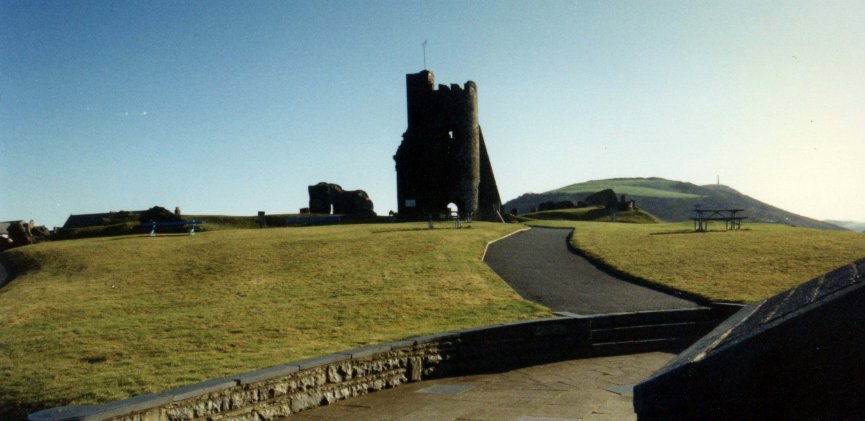Aberystwyth

There are two castles at Aberystwyth. The first
lies on top
of a rise two miles south of the present castle and was probably built
by the Clares
before 1116, when it was unsuccessfully attacked by the Welsh under
Prince Gruffydd ap Rhys of Deheubarth (d.1137). This first
castle was subsequently
destroyed by Owain Gwynedd (d.1170) and his brother, Cadwalladr ap
Cynan (d.1172) in 1136. In 1143 the
castle had been rebuilt and was held by Cadwaladr when it was burned by
his nephew, Hywel ab
Owain (d.1170). In 1208 the castle belonged to Maelgwn ap
Rhys (d.1230) when he
destroyed it lest it fell to his enemies led by Llywelyn ab
Iorwerth (d.1240). King John rebuilt the castle in 1211, but
it fell to
Maelgwn and his nephew, Rhys Ieunac (d.1222) the same year.
In 1221 Prince Llywelyn
took it from Rhys, but before 1234 it had passed into the hands of
Rhys' brother, Owain ap Gruffydd (d.1235).
The first earthwork castle lies south of the River Ystwyth on high
ground. The later main castle lies north of the river, close
to
the shore and this fortress was built, or possibly rebuilt
between 1277 and 1289 by Prince Edmund (d.1296), the brother of King
Edward I,
using royal forces and masons. The initial design was not a
great
success and part of the outer castle rapidly fell into the
sea.
Afterwards the castle was sacked in 1282 and Master James St George was
brought in
to effect repairs. In all the fortification of Aberystwyth
cost over £4,300 - less than half that expended on
refurbishing Harlech
castle.
This would again suggest that much of Aberystwyth castle was already
standing before the Edwardian masons arrived in 1277. During
the
French emergency of 1370 the castle was garrisoned by a constable and
10 archers. In 1404 it fell to Glyndwr and was massively
damaged
in the subsequent 1408 siege by Prince Hal. The castle fell
again
to the guns of the parliamentarians in 1646.
The castle is now concentric in plan and consists of a diamond shaped
outer ward, with two small twin towered gatehouses to the east and NW.
There are the remains of
round towers at the other 3 cardinal points. Set within this
was
an irregular inner ward which backed against the long SW outer
wall. This had a massive twin towered gatehouse to the east,
directly
behind one of the outer gatehouses. This
style of great twin towered gatehouse with twin round stair turrets to the rear can also be
found in Wales
at Caerphilly, Harlech
and Llanstephan, but in England only at Tonbridge
in Kent. There
are also the enlongated versions of such gatehouses at Llangibby
and Beaumaris.
At Aberystwyth on the other side of the inner ward to the great gatehouse was a small D shaped
gatetower, standing behind
another twin D towered outer
gate. The two outer gates are similar to those found
elsewhere in the British Isles. English examples survive at
Beeston, Bungay, Clifford,
Dover, Longtown, Pembridge, St Briavels, the
Tower of London
and Whittington.
In Wales they exist at Caerphilly,
Carmarthen, Chepstow, Criccieth, Degannwy, Dinas Bran,
Llawhaden, Neath, Oystermouth, Powis, Rhuddlan, Tinboeth and White Castle.
In Scotland
they can be found at Kildrummy
and Urquhart
and finally elsewhere in Ireland at Carrickfergus,
Castle Roche, Limerick and Roscommon.
At a later date a new
wall was added down the SW side of the inner ward. This
contained
a central D shaped tower and made the inner ward concentric.
What
date these works are is open to question, and all that can
realistically be said is that the division of the inner
ward from the outer probably dates to after 1276 and before 1290.
Why
not join me at other Lost Welsh Castles next Spring?
Please see the information on tours at Scholarly
Sojourns.
Copyright©2010
Paul Martin Remfry

